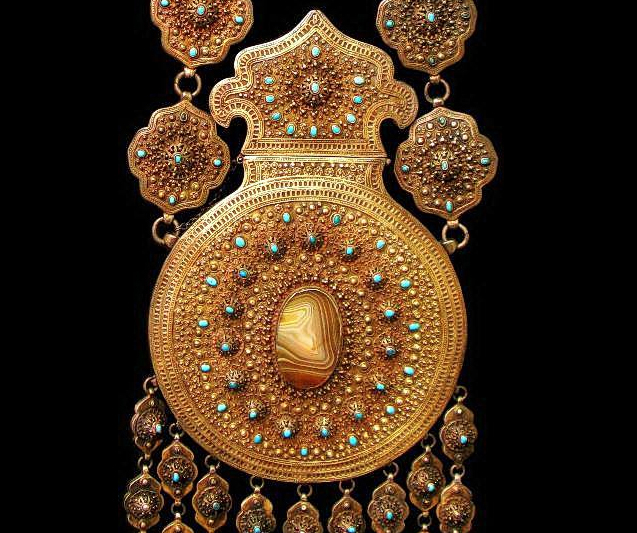This is a large yet very finely made necklace-like piece, but even larger ones exist. They are considered to come from Bukhara, c. 1900, and to have been used at the Emir’s court. It is not entirely clear whether these pieces were, as often suggested, made to be worn by horses (which were regularly adorned with jewelry) or as amulets meant to hang on a wall (as happened in the case of e.g. very large Turkoman pieces). A large agate composes the center of the major circular component. Only a comparatively small number of these objects have been sold in the West – most of them by Christie’s in 2005 (one already in 2004). The Christie’s pieces came from the estate of Kate Kemper, who died in 2004 (she was born in 1908). This piece was bought by us from London dealer Michael Backman. He had, at the same time, a larger one as well; that seemed to us too grand for our house, but, after we decided against it, it was immediately sold to an important museum which like us – but after us – had taken out an option on both pieces.
The color of the amulet is, if viewed in daylight of without strong artificial light, far less bright than it is in the Backman photo here shown. This makes some people feel that the piece must be modern or at the very least has been re-gilt. However, if not viewed on this photo, the piece looks entirely “normal” as a silver-gilt ornament: i.e. as one made of silver, with a thin coating of gilding, which in many places has worn off.
Backman’s description of the piece is very detailed and based on sound research. As these pieces are little known, and often seriously misunderstood, we quote Backman’s information in full. It is of interest not only with regard to this piece, but also other similar ones, and – more widely – explains how a number of them ended up in the West as early as 1920, which proves that they were made no later than that date. Of the number bought by one American individual several (or all) must have ended up with Kate Kemper, as after her death in 2004 quite a few pieces were sold from her estate, mostly by Christie’s, though not all, for this piece is described by Backman as from Kate Kemper, but was not, as far as we can find out, auctioned. A majority of these pieces have ended up in museums – ours is unusual in being in private hands. We cite Backman’s information about this piece below:
———–
Large, Rare Silver Gilt, Turquoise & Agate Equestrian Koranic Amulet Case,
Emirate of Bukhara, 19th century
, height: 92cm, width: 25cm
weight: 1.784 kg.
This massive hollow ornament of gold-covered, high-grade silver embellished with semi-precious stones was made to hold Koranic verses and other items with amulet-like properties. Possibly it was worn around the neck of a horse most probably on the occasion of a wedding procession, but otherwise would have hung on a wall inside an aristocratic house as a protective device.
Almost certainly it came from the holdings of the Emir of Bukhara or a similarly aristocratic family. The Emir’s family and other aristocratic families lost their assets in 1920 when the Emirate was overrun by Russia’s Red Army and the position of Emir was abolished. Almost all other known similar large amulet boxes, including this example, were acquired by a single American collector around this time. A large amulet of related form but decorated with enamel work rather than applied gilded silver work is in the collection of Kuwait’s Tareq Rajab Museum. The Kuwait piece is provenanced to the ‘last emirs of Bukhara’ (Tareq Rajab Museum, 1994, p. 76.)
The crest-like top of the amulet box is hinged on one side and lifts up to allow access to the interior. It is kept closed by means of a silver pin attached to a silver chain.
The box is suspended from two chains of four gilt pendant cartouches each, and these are suspended from a double chain of finely twisted silver wire.
Nine chains of suspended pendants hang from the ornament. These, like the other pendants and the amulet box itself, are of silver gilt, with numerous filigree bosses and filigree floral applique, and turquoise and turquoise ceramic cabochons. (See the last, detailed image.)
A large slice of banded agate is mounted in the center of the amulet box.
The Emirate of Bukhara was a Central Asian state that existed between 1785 and 1920. It occupied a region formerly known as Transoxiana.
The ancient trading outposts of Samarkand and the emirate’s capital, Bukhara, were the principal cities and it bordered the Khanates of Khiva and Kokand. It is now within the boundaries of Uzbekistan.
The Emirate was founded in 1785 by the the Manghit emir, Shah Murad. The Emirate lost a war with Imperial Russia in 1868 and Russia annexed most of the Emirate’s territory. The Emirate became a Russian protectorate in 1873. The position of the Emir remained of which Abd al-Ahad (Emir 1885-1910) was particularly notable. (This amulet most probably dates from his rule.) The conservative Emir Mohammed Alim Khan was removed in 1920 when the Emirate was over-run by the Red Army and the Bukharan People’s Soviet Republic was established.
Several similar amulets were included in Christie’s New York, ‘Indian and Southeast Asian Art’, March 31, 2005, lots 213-217.
Overall, this is a rare, visually stunning, extraordinary item from the Islamic world. It is in excellent condition, contains a great deal of high-grade silver and is ideal for display mounted against a wall.
Provenance: the Kate Kemper Collection
References:
Mansel, P., Sultans in Splendour: Monarchs of the Middle East 1869-1945, Parkway Publishing, 1988.
Tareq Rajab Museum, Tareq Rajab Museum, Kuwait, 1994.
Christie’s New York, ‘Indian and Southeast Asian Art’, March 31, 2005, lots 213-217.

